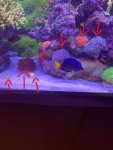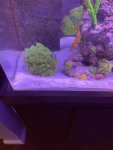So here's my take of keeping corals (no matter what species or group). Strive for stability no matter what, it's the fluctuations that cause most issues in our tanks. Don't get hung up on numbers, this is the wrong way of looking at keeping a reef tank. What works for someone else's tank won't necessarily work in yours. Each tank is it's own unique ecosystem, so observation is the key here. Shoot for NSW parameters at first and adjust from there. With LPS, you need to consider that part of how they intake nitrogen is through direct feeding, whether that be from your hands or from just feeding your fish and let the extra food and fish waste feed the corals (which is what I do). On top of that you need to consider certain trace elements being replenished, either through routine water changes or direct dosing of certain elements. If you're dosing trace elements directly, then you need to test for the things you're dosing. Besides keeping the big 3 stable, Goni's benefit from additions of manganese, iron and iodide (iron and manganese being the most important). Again, if you're dosing it, test for it. Also, dosing phyto on a regular basis does wonders for any reef tank, especially those with corals. Phyto is the start of the food web that really helps increase biodiversity in our tanks (and the reefs). Nutrient levels are probably where most people go wrong and have the hardest time dealing with, either too much or too little. If you can measure nitrates with a test kit, you have enough and most people will be fine with a few ppm of NO3. The biggest issue is PO4, this is where people really get into trouble. In new tanks you should try and keep PO4 between 0.05 to 0.1ppm (somewhere in the middle or on the lower end of this range is usually best), this helps you keep algae under control until you can stabilize the balance between PO4 and NO3 (and there needs to be a balance). Once your tank matures, PO4 can be a little closer to 0.1ppm (give or take a couple, think 0.08 to 0.12ppm). So here's the caveat with these numbers, it's really based on how you feed your tank? If you're a heavy feeder like me (I mean several small feedings throughout the day, not one big feeding, which is the worst way to feed your tank/fish), then it's probably safer to be at or just below the 0.1ppm mark and still have room to work with. If like me, heavy in/heavy out, then direct feeding isn't really necessary. But if you have a light feeding approach, then supplemental feeding will be very helpful, reef roids, oyster feast, etc. Usually your PO4 is closer to the 0.02 to 0.05 range, so this supplemental feeding will help. If anyone tells you about the Redfield ration, run as fast as you can in the opposite direction, because they have no idea what it really means and how it has nothing to do with our tanks whatsoever. Sorry, I got sidetracked, if you're able to grow algae on the glass every couple days, you're good. I know this is an old school way of approaching this, but it works. And for those worried about algae because of certain numbers, you don't have an algae/nutrient problem, you have a herbivore problem. The numbers that I listed here are merely guidelines/ranges and are not set in stone, like I said, each tank will be different, you just have to find the range that works best for you. Hopefully there's some useful info here?




